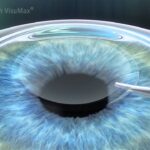WHAT IS SMILE LASER VISION CORRECTION?
SMILE (small incision lenticular extraction) is a relatively new laser vision correction procedure that is an alternative to LASIK and PRK. SMILE involves two steps: 1) a small incision is created with the laser at a similar diamter to where a LASIK flap edge would be and then 2) the laser is then focused within the cornea to sculpt out a disc shaped segment of tissue called the lenticle. The lentical is then removed through the small incision creating a cavity in the cornea. The top of the cornea then sinks down to fill in that cavity, changing the shape of the cornea and correcting nearsightedness and astigmatism.
NEW STUDY ON SMILE LASER EYE SURGERY
A study published this month in the British Journal of Ophthalmology compared the safety and efficacy of SMILE in patients under age 35 versus those over age 40. 102 eyes of 53 patients were included in the study. Results were recorded at six months after surgery. In the words of the authors, “Post-SMILE refractive outcomes in those patients over 40 years of age, although acceptable, are not as good as those obtained in younger patients, showing a significantly lower efficacy and safety indexes, and poorer astigmatic outcomes, with a tendency towards undercorrection.” There is a theory that the human cornea becomes stiffer and biomechanically stronger with age. The authors felt that this increase in stiffness might be causing the lower safety and efficacy found in the older patient group. Ironically, this increase in corneal strength would in theory only help the results of LASIK or PRK, certainly not hinder them.

